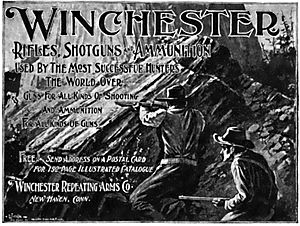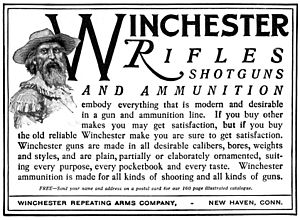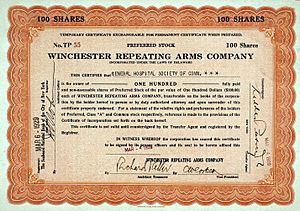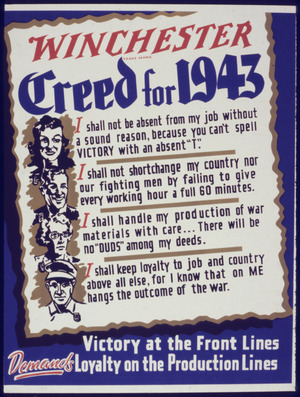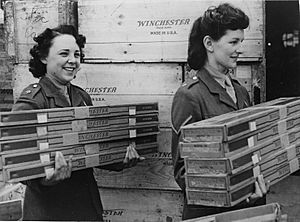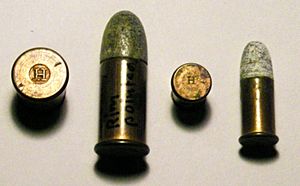Winchester Repeating Arms Company facts for kids
| Private | |
| Industry | Arms industry |
| Fate | Bought by Western Cartridge Company (which later became part of the Olin Corporation) |
| Predecessor | New Haven Arms Company |
| Successor | Winchester-Western Company |
| Founded | 1866 |
| Founder | Oliver Winchester |
| Defunct | 1931 (receivership) |
| Headquarters |
,
U.S.
|
| Products | Firearms, ammunition and accessories |
The Winchester Repeating Arms Company was a famous American company. It made firearms that could shoot many times without reloading, called repeating firearms. They also made ammunition.
Oliver Winchester started the company in 1866. It was located in New Haven, Connecticut. In 1931, the company faced financial trouble and was bought by the Western Cartridge Company. This company later became part of the Olin Corporation.
Today, the Winchester name is still owned by Olin Corporation. They make ammunition under this name. Other companies, like FN Herstal and Browning Arms Company, also use the Winchester name to make firearms. These companies are part of the Herstal Group.
Contents
How Winchester Started
Early Companies
The story of Winchester began with a partnership in Connecticut. It was between Horace Smith and Daniel Wesson. They bought a design for a rifle that could shoot many times. This design came from an inventor named Walter Hunt. His "Volition Repeating Rifle" used special "Rocket Ball" ammunition.
The rifle design was improved by Lewis Jennings. A company called Robbins & Lawrence made a few of these rifles. But they did not sell well. So, Robbins & Lawrence stopped making them in 1852. Smith then made a much better rifle based on Jennings' design. They also hired a skilled worker named Benjamin Tyler Henry.
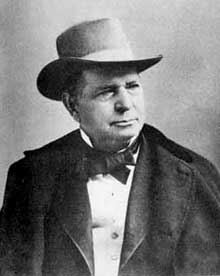
In 1855, Smith and Wesson found investors. They started the Volcanic Repeating Arms Company. Their goal was to make the "Volcanic" rifle and pistol. Oliver Winchester, a clothing maker, was a big investor. The Volcanic rifle was not very successful. The company moved to New Haven in 1856. By the end of that year, it ran out of money.
Oliver Winchester and his partner bought the company's assets. They renamed it the New Haven Arms Company in 1857.
After Smith left, Benjamin Henry kept working on a new type of bullet. He perfected a powerful rimfire cartridge called the .44 Henry. Henry also designed a new rifle to use this bullet. It was based on the Volcanic design. This new rifle became the Henry rifle of 1860. The New Haven Arms Company made it. Many Henry rifles were used by soldiers during the American Civil War. The Henry rifle helped the New Haven Arms Company become successful. It also made lever-action rifles popular.
The Winchester Rifle
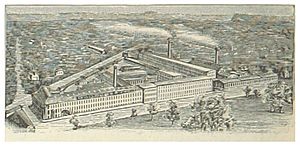
In 1866, Benjamin Henry tried to take ownership of the company. He felt he was not paid enough. Oliver Winchester quickly returned from Europe. He stopped Henry's plan. Winchester then reorganized the New Haven Arms Company. He renamed it the Winchester Repeating Arms Company.
Winchester made big improvements to the Henry rifle. This led to the first Winchester rifle, the Model 1866. It used the same .44 caliber bullets as the Henry. But it had a better magazine. It also had a loading gate on the side, invented by Nelson King. For the first time, it had a wooden front part. Both the Henry and the 1866 Winchester had a special firing pin. It hit the bullet in two places. This made sure the bullet would fire.
Another very popular model came out in 1873. This was the Model 1873. It was the first Winchester rifle to use a center-fire bullet, the .44-40 WCF. These rifles are often called the "Gun That Won the West."
The Model 1873 was followed by the Model 1876. This was a larger version of the '73. It used similar parts. It could fire longer, more powerful bullets. But it could not use the very powerful .45-70 Government bullet. This changed when Winchester started making the Model 1886. This rifle was designed by John Browning.
Oliver Winchester passed away in 1880. His son, William Wirt Winchester, died four months later. William Wirt Winchester's wife, Sarah Winchester, used her money. She built what is now known as the Winchester Mystery House.
From 1883, John Browning worked with Winchester. He designed many famous rifles and shotguns. These included the Model 1885 Single Shot, the Model 1887 shotgun, and the Model 1897 shotgun. He also designed the lever-action Model 1886, Model 1892, Model 1894, and Model 1895 rifles. Some of these designs are still made today by other companies.
Winchester in the 20th Century
Early 1900s Developments
In the early 1900s, Winchester faced competition. Other companies were making new designs by John Browning. Winchester wanted to make the first self-loading rifle. This led to the .22 rimfire Winchester Model 1903. Later, they made centerfire rifles like the Model 1905, Model 1907, and Model 1910.
Winchester engineers worked for ten years. They designed the Model 1911 shotgun. This design avoided Browning's patents. A key engineer, T.C. Johnson, helped create these self-loading firearms. He also designed the classic Model 1912 shotgun, Model 52, and Model 54 rifles.
World War I
Winchester was a big producer during World War I. They made the .303 Pattern 1914 Enfield rifle for the British Government. They also made the .30-06 M1917 Enfield rifle for the United States.
While working at Winchester, Browning finished the design for the Browning Automatic Rifle (BAR). Winchester made about 27,000 of these. Browning and Winchester engineers also developed the Browning .50 caliber machine gun. Winchester ballistic engineers designed the .50 BMG (12.7 x 99 mm) ammunition for it.
Financial Challenges and Recovery
During World War I, Winchester borrowed a lot of money to grow. After the war, they tried to use their factories to make other things. They made kitchen knives, roller skates, and even refrigerators. They hoped this would help pay off their debts. They also joined with another company, Simmons Hardware Company. This plan did not work well for Winchester.
The Great Depression made things even harder. The Winchester Repeating Arms Company faced serious financial trouble in 1931. It was bought by the Western Cartridge Company. This company was owned by the Olin family. The original Winchester company officially ended in 1935. Western Cartridge then formed the Winchester-Western Company. Later, in 1944, the gun and ammunition parts became the Winchester-Western Division of Olin Industries.
The head of Western, John M. Olin, loved guns. He worked to make the Winchester brand great again. He focused on classic models and improved them. He made sure they were high quality. Winchester did well, even during the Depression.
World War II
Winchester designed the U.S. M1 carbine. An eight-person team at Winchester created it. More M1 carbines were made during World War II than any other U.S. small gun.
During World War II, Winchester also made the M1 Garand rifle. After the war, they were the first civilian company to make the M14 rifle.
Later Decline
By the 1960s, it became very expensive to make Winchester's classic guns. They needed a lot of hand-work. Their popular Model 12 pump shotgun and Model 70 bolt-action rifle were too costly. They could not compete with cheaper guns from other companies.
So, Winchester changed its designs in 1963–1964. They used "modern" ways to make guns. But people did not like the new guns. Many felt Winchester had lowered its quality. This caused Winchester to lose many customers. Even today, gun collectors prefer older Winchester guns. They are considered more valuable.
Making guns in New Haven became too expensive. A long strike by workers from 1979 to 1980 was the final push. In 1980, the New Haven factory was sold to its employees. They formed the U.S. Repeating Arms Company. They were allowed to keep making Winchester guns. Olin kept the Winchester ammunition business.
U.S. Repeating Arms went bankrupt in 1989. A French company bought it. Then it was sold to a Belgian company, Herstal Group. This group also owns Fabrique Nationale d'Herstal (FN) and Browning Arms Company.
On January 16, 2006, U.S. Repeating Arms announced it would close its New Haven factory. Winchester rifles and shotguns had been made there for 140 years. This meant the Model 94 rifle, Model 70 rifle, and Model 1300 shotgun would no longer be made there.
U.S. Repeating Arms Company To Close New Haven, CT Facility – U.S. Repeating Arms Company, maker of Winchester brand rifles and shotguns will close its New Haven, Connecticut manufacturing facility. Many efforts were made to improve profitability at the manufacturing facility in New Haven, and the decision was made after exhausting all available options.
Effective March 31, 2006, the New Haven manufacturing facility will stop manufacturing the Winchester Model 70, Model 94 and Model 1300.
Winchester Firearms will continue to sell and grow its current line of Select Over & Under shotguns, the new Super X3 autoloading shotgun, the new Super X autoloading rifle and Limited Edition rifles. The company also plans to introduce new models in the future. There will be no change in Customer Service.
This action is a realignment of resources to make Winchester Firearms a stronger, more viable organization. Winchester Firearms plans to continue the great Winchester legacy and is very excited about the future.
Modern Recovery
On August 15, 2006, Olin Corporation (who owns the Winchester name) made a new agreement. They allowed Browning to make Winchester rifles and shotguns. But these would not be made at the old New Haven factory.
Today, some Winchester rifles are made in Japan by Miroku Corp. Browning imports them to the United States. These include the Model 1885 and the Model 1892.
In 2008, Fabrique Nationale (FN) announced they would make Model 70 rifles. These were made in South Carolina. In 2013, the assembly moved to Portugal.
In 2010, FN started making the Winchester Model 1894 again. They also continued the Winchester 1300 shotgun, now called the Winchester SXP.
Many other items are also sold under the Winchester name. These include gun cleaning kits, knives, and tools.
Ammunition
Winchester's success began with a bullet, the .44 Henry rimfire. The Henry and 1866 rifles were designed for it. Winchester was a top designer of rifle ammunition for a long time. They created many successful bullets.
Some famous Winchester bullets include the .44-40 WCF, the .30 WCF (.30-30), the .50 BMG, the .270 Winchester, the .308 Winchester, and the .300 Winchester Magnum. In North America, the .30-30 is the best-selling hunting bullet ever. The .308 Winchester is also very popular for hunting worldwide.
Olin Corporation still makes Winchester ammunition today. They have different lines of bullets for various uses.
Presidents
- Oliver Winchester (1857–1880)
- William Wirt Winchester (1880–1881), Oliver Winchester's son
- William Converse (1881–1890)
- Thomas Grey Bennett (1890–1910)
- George E. Hodson (1910–1915)
- Winchester Bennett (1915–1918)
- Thomas Grey Bennett (1918–1919)
- John Edward Otterson (1919–1924)
Images for kids
See also
 In Spanish: Winchester Repeating Arms Company para niños
In Spanish: Winchester Repeating Arms Company para niños


